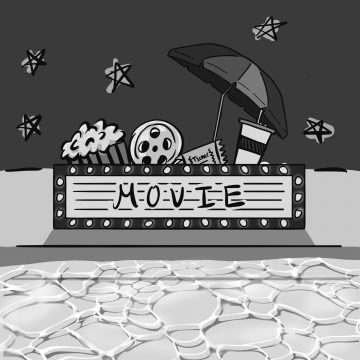“The Zone of Interest”
4/5 ****
Content warning: this article includes discussion of the Holocaust and crimes against humanity.
“The Zone of Interest” is a 2023 historical film directed by Jonathan Glazer. At the 96th Academy Awards, the film was nominated for Best Picture and won for Best International Feature Film and Best Sound. I am going to do my best to not give away too much detail about the film’s content and be as vague as possible. If you want to go into the film not knowing anything, I recommend watching the film first before reading this review.
The film focuses on Rudolf Höss (Christian Friedel), the SS Officer and commandant of Auschwitz, specifically Auschwitz I, the main camp that served primarily as a work camp. Höss lived next to Auschwitz with his family and oversaw the camp’s activities from May 1940 to November 1943, being there from the beginning. The film’s message is to get the viewer to connect the lives of the Höss family to our own, showing how easy it is for those who have privileged lives to ignore atrocities happening right under our noses. From the rise of anti-transgender rhetoric in the U.S. to Israel’s ongoing invasion and bombardment of Palestinian lands, we are all susceptible to allowing other people’s pain and suffering to become a part of our daily lives.
What makes this film so powerful is its use of sound. The lack of non-diegetic music (music that does not exist in the universe of the film) and the near constant sounds of the camp leads to an extremely haunting experience.
Each member of the Höss family, save for the baby and the family dog, are comfortable with their surroundings. The best and simplest way to describe this film is horrifying. Watching the Höss family living their normal lives under the backdrop of screams, gunshots and rumblings of the crematorium — horrifying. Listening to Hedwig Höss (Sandra Hüller) describe how she has her “dream garden” and “dream home” while she lives next to a place worse than nightmares — horrifying. Seeing Höss discussing plans to exterminate human beings as if it were just a normal business conversation — horrifying. Hearing, not seeing, inside the gates of Auschwitz leading to the mind filling in the blanks of the terrors that are occurring — horrifying.
The only times that the film features non-diegetic music are at the beginning and end, where extremely haunting scores by Mica Levi play as the audience just stares at a black screen. It is hard to put into words what sort of feelings are forced up from your subconscious, especially when all you are doing is listening with a black screen in front of you. The score at the end is especially terrifying. “A sense of approaching doom” is too simple of a phrase to describe what I was feeling while simultaneously listening to that score and processing what I just saw.
At first, it is hard to grasp how the Höss family were all able to live in a place like that, until you remember that this is a pattern across history. The 19th century saw people witnessing the enslavement of Black people in the Antebellum South and doing nothing. In the 1930s and 1940s there were witnesses to the oppression and extermination of Jewish people and others in Nazi Germany who did nothing. Today, there are people witnessing the slaughter of Palestinian and Ukrainian civilians and doing nothing.
Either watching the news or scrolling through social media, we see suffering all the time, but we are desensitized to it. When there are ads on places like YouTube spreading word about the humanitarian crises around the world, it is so easy to just click “skip ad” without a second thought. When people spread awareness on social media, it is so easy to like and keep scrolling without doing any actual actions to help. I myself have done this, telling myself “not today” every day whenever I see people post about the horrors happening in the world. This film is one of those wakeup calls telling us that not everyone can choose to ignore horror because they are living it.
The film not only shows the Höss family, but also shows a Polish girl (Julia Polaczek) as well, inspired by Aleksandra Bystroń-Kołodziejczy, who was a member of the Polish Home Army. Aleksandra would leave food around the camp for the prisoners. Filmed under a thermographic camera, Aleksandra glows against the darkness, reflecting the little slivers of hope she manages to bring to the prisoners. Aleksandra, despite being a child, manages to find a way to help these prisoners, unlike the people living on the Höss’s property. Not even the maids of the household or even Hedwig’s mother try to do anything; they simply ignore the screams from over the garden wall.
The film’s ending is a slap in the face to the audience. Without giving too much away, the audience sees the consequences of doing nothing, then is given a choice — to live in blissful ignorance, or to take initiative and do something, anything, to help those suffering. Glazer asks: do we want to go down in history as the Höss family or as Aleksandra?
Overall, this film was a horrifying and impactful experience. The way Glazer uses sound and imagery makes for a film that will truly stick with you for a long time. This film truly deserved the Oscar for Best Sound and should have also won Best Picture. The Höss family have normalized the sounds of screaming and gunshots, just as we have normalized the images of bombed out cities and dead civilians. By allowing ourselves to be desensitized, crimes against humanity are allowed to continue.

